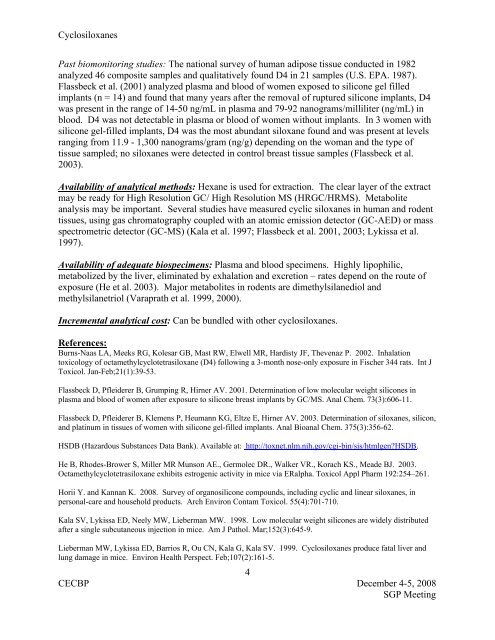Document: Cyclosiloxanes - OEHHA
Document: Cyclosiloxanes - OEHHA
Document: Cyclosiloxanes - OEHHA
Create successful ePaper yourself
Turn your PDF publications into a flip-book with our unique Google optimized e-Paper software.
<strong>Cyclosiloxanes</strong><br />
Past biomonitoring studies: The national survey of human adipose tissue conducted in 1982<br />
analyzed 46 composite samples and qualitatively found D4 in 21 samples (U.S. EPA. 1987).<br />
Flassbeck et al. (2001) analyzed plasma and blood of women exposed to silicone gel filled<br />
implants (n = 14) and found that many years after the removal of ruptured silicone implants, D4<br />
was present in the range of 14-50 ng/mL in plasma and 79-92 nanograms/milliliter (ng/mL) in<br />
blood. D4 was not detectable in plasma or blood of women without implants. In 3 women with<br />
silicone gel-filled implants, D4 was the most abundant siloxane found and was present at levels<br />
ranging from 11.9 - 1,300 nanograms/gram (ng/g) depending on the woman and the type of<br />
tissue sampled; no siloxanes were detected in control breast tissue samples (Flassbeck et al.<br />
2003).<br />
Availability of analytical methods: Hexane is used for extraction. The clear layer of the extract<br />
may be ready for High Resolution GC/ High Resolution MS (HRGC/HRMS). Metabolite<br />
analysis may be important. Several studies have measured cyclic siloxanes in human and rodent<br />
tissues, using gas chromatography coupled with an atomic emission detector (GC-AED) or mass<br />
spectrometric detector (GC-MS) (Kala et al. 1997; Flassbeck et al. 2001, 2003; Lykissa et al.<br />
1997).<br />
Availability of adequate biospecimens: Plasma and blood specimens. Highly lipophilic,<br />
metabolized by the liver, eliminated by exhalation and excretion – rates depend on the route of<br />
exposure (He et al. 2003). Major metabolites in rodents are dimethylsilanediol and<br />
methylsilanetriol (Varaprath et al. 1999, 2000).<br />
Incremental analytical cost: Can be bundled with other cyclosiloxanes.<br />
References:<br />
Burns-Naas LA, Meeks RG, Kolesar GB, Mast RW, Elwell MR, Hardisty JF, Thevenaz P. 2002. Inhalation<br />
toxicology of octamethylcyclotetrasiloxane (D4) following a 3-month nose-only exposure in Fischer 344 rats. Int J<br />
Toxicol. Jan-Feb;21(1):39-53.<br />
Flassbeck D, Pfleiderer B, Grumping R, Hirner AV. 2001. Determination of low molecular weight silicones in<br />
plasma and blood of women after exposure to silicone breast implants by GC/MS. Anal Chem. 73(3):606-11.<br />
Flassbeck D, Pfleiderer B, Klemens P, Heumann KG, Eltze E, Hirner AV. 2003. Determination of siloxanes, silicon,<br />
and platinum in tissues of women with silicone gel-filled implants. Anal Bioanal Chem. 375(3):356-62.<br />
HSDB (Hazardous Substances Data Bank). Available at: http://toxnet.nlm.nih.gov/cgi-bin/sis/htmlgen?HSDB.<br />
He B, Rhodes-Brower S, Miller MR Munson AE., Germolec DR., Walker VR., Korach KS., Meade BJ. 2003.<br />
Octamethylcyclotetrasiloxane exhibits estrogenic activity in mice via ERalpha. Toxicol Appl Pharm 192:254–261.<br />
Horii Y. and Kannan K. 2008. Survey of organosilicone compounds, including cyclic and linear siloxanes, in<br />
personal-care and household products. Arch Environ Contam Toxicol. 55(4):701-710.<br />
Kala SV, Lykissa ED, Neely MW, Lieberman MW. 1998. Low molecular weight silicones are widely distributed<br />
after a single subcutaneous injection in mice. Am J Pathol. Mar;152(3):645-9.<br />
Lieberman MW, Lykissa ED, Barrios R, Ou CN, Kala G, Kala SV. 1999. <strong>Cyclosiloxanes</strong> produce fatal liver and<br />
lung damage in mice. Environ Health Perspect. Feb;107(2):161-5.<br />
4<br />
CECBP December 4-5, 2008<br />
SGP Meeting















